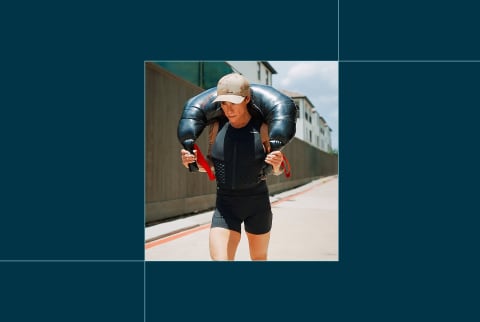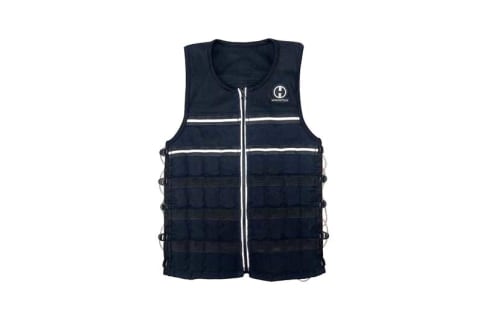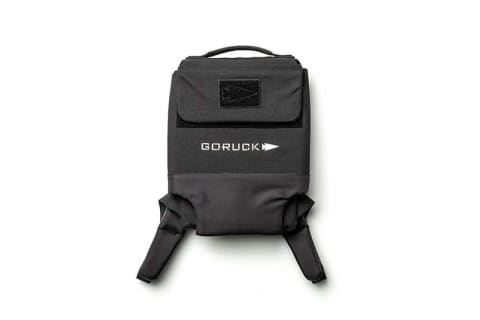Advertisement
What Is Rucking? 10 Benefits For Women + Expert Tips For How To Get Started


Think of the times you've walked around with a heavily loaded backpack or with the weight of your child strapped to you; many experts would argue you've been rucking all along.
“First, it was the Baby Bjorn carrier with my first son, and then I had my second and added a backpack carrier,” says celebrity fitness trainer JJ Virgin. “Likely, we’ve all actually ‘rucked’ in our lives; we just didn’t call it that!”
In my own experience as a woman who wants to live longer and better, building strength has become my number one goal—and lately, it seems all signs are pointing to rucking as a way to get there.
The simple yet effective low-impact exercise is nothing new, but it's recently taken the fitness world by storm.
Rucking targets key muscle groups in your legs, upper body, back, and core to promote improved strength (and yes, longevity!), and studies have linked it to stronger aerobic capacity1, muscular endurance2, increased calorie burn3, and improved bone health.
Of course, if you're new to rucking, there are a few factors you'll want to consider to truly reap the benefits. Below, learn from experts, researchers, and rucking enthusiasts how to get started with rucking and what to expect once you do.
Likely, we’ve all actually ‘rucked’ in our lives, we just didn’t call it that!
What is rucking?
Put simply: Rucking is the act of walking or hiking while wearing weight on your back.
"It is an excellent way to increase the efficiency and intensity of a workout," says functional medicine doctor Gabrielle Lyon, D.O., who has incorporated the activity into her routine for a decade.
Some rucking purists argue that rucking requires weight on your back and carrying at least 30% of your body weight. Others (including most experts we spoke with) use the term rucking loosely to describe exercising with either a weighted vest or backpack.
This lends the question: When do I use a rucking backpack versus a weighted vest?
“I will use a backpack for longer, more formal walks or hikes outside,” Lyon explains. “I incorporate a vest in other styles of training like intervals on the bike, walking at my treadmill desk during meetings, or as an extra load during strength training sessions.”
Whether you opt for standard rucking with a backpack or choose to incorporate a weighted vest into an existing workout, all the experts we interviewed recommended starting small (5 to 10% of your body weight) and building up.
Once you're more experienced, you can begin using heavier equipment for rucking. But we'd still recommend sticking with a weighted vest equivalent to (or less than) 15% of your body weight for running or other high-intensity exercises.
Summary
Rucking has helped me build both muscular strength and endurance as it brings both cardiovascular and strength training together.
The benefits of rucking
Research estimates that we lose around 3 to 8% of our muscle mass4 every decade after the age of 30. What's more, up to 16% of people over the age of 65 have sarcopenia (age-related muscle loss), and women tend to present with this issue earlier than men.
Sarcopenia puts us at a higher risk of cognitive decline5 and increased susceptibility to infection6 and metabolic syndrome7, and it's also been correlated with osteoporosis8.
One major antidote? Strength training, which we already know has massive benefits to health and longevity. Not only does strength training play a vital role in muscle protein synthesis, but studies show it can significantly improve muscle strength and muscle quality in elderly patients with sarcopenia9.
Rucking is a safe and impactful way to integrate weight training into your routine. It gives you all the benefits of strength training and of walking (and then some).
Rucking is convenient and versatile
Weighted vests can be added to most exercises, and rucking backpacks are a great way to add intensity to walks or hikes.
“I will even throw on a weighted vest to pick up my kids from school,” Lyon says.
Whether you're carrying a vest, a rucksack, or your own child as a weight, you won't need to overhaul your routine to start rucking.
Rucking supports everyday movement
On a recent episode of the mindbodygreen podcast, Virgin emphasized the importance of training to "get better at life." By focusing on the muscles you’ll use today, tomorrow, and 30 years from now, you’ll set yourself up to feel stronger and healthier in everyday life. And per Virgin, that's exactly what rucking does. “When you walk around with a 10 to 15 pound rucking vest on and then take it off, it makes your activities of daily living feel much easier," she says.
Rucking helps build muscle
There’s no question about whether rucking is an impactful strength-building workout. Strapping weight to your back while walking or hiking will increase muscular strength in your back, legs, core, and upper body.
One small study on adults over 65 found that weighted step exercises helped improve leg strength2 and physical function. Another study compared loaded-walking to unloaded and saw significant improvement in physical performance for participants in the loaded group.
“Rucking has helped me build both muscular strength and endurance as it brings both cardiovascular and strength training together,” says Lyon.
Rucking helps improve cardiovascular health
Rucking is a cardio exercise at its core, and studies show adding additional load to your workout can help improve your cardiovascular biomarkers10 (specifically your VO2 max, the number one longevity metric).
“[Rucking is] a great way to improve cardiovascular fitness because [your] heart rate elevates more quickly,” Lyon explains. “It’s more effective at building cardiovascular endurance than walking, yet kinder on joints than running.”
Certified orthopedic surgeon Vonda Wright, M.D., M.S. also touts these benefits. “I have personally found that wearing a 20-pound weighted vest increases my heart rate by about 10 bpm when doing my normal zone 2 pace and incline on a treadmill,” she adds.
When you walk around with a 10 to 15 pound rucking vest on and then take it off, it makes your activities of daily living feel much easier.
Rucking promotes joint and bone health
As low-impact exercise, rucking is easier on your joints than activities like running or HIIT. But as a weight-bearing exercise, it also promotes stronger joints and healthier bones.
Research on postmenopausal women shows training in a weighted vest can prevent bone loss11 and reduce the risk of fractures and osteoporosis, which is incredibly important since our bones naturally get weaker as we age12.
“Hiking with a weighted vest is a great way to add an element of bone health to your cardio workout,” Wright explains. “The added impact of a weighted vest sends the biomechanical signals to your bones that they need to be stronger under the extra load and will stimulate more bone building.”
Rucking increases mental toughness
“When you do hard things, it makes everything else easier (physically and mentally),” Virgin says. Rucking improves both physical and mental toughness by showing you that you are capable of accomplishing difficult tasks.
Lyon agrees, adding that “Rucking builds mental toughness and resilience while getting me moving and outside.”
Rucking encourages you to get outside
On that note: Rucking encourages you to spend more time moving outside, which has been linked with a better mood13, improved cognitive function14, reduced blood pressure15, and even better sleep16.
“For me, this extra movement and outdoor time also helps me manage stress,” Lyon adds.
Rucking can increase calorie burn
Some research has linked weighted vests to increased calorie burn17, which can contribute to weight loss and better metabolic health.
Lyon agrees, confirming that “You burn more calories by throwing on a weighted vest or backpack.”
Rucking can improve your posture, form, & balance
In my own experience, rucking and training in a weighted vest has made me more aware of my form while performing certain exercises. I’ve also seen significant improvements in my balance and posture—and experts back these benefits as well.
“You may find that with regular rucking and proper form, your posture can even improve,” Lyon agrees. She stresses that it’s important to use a vest or backpack with evenly distributed weight.
Rucking requires minimal equipment to get started
Many modern fitness trends involve equipment, workout apps, or in-person classes, but rucking is as simple as finding the best rucksack and integrating it safely into your routine.
Rucking for beginners
Ready to ruck but not sure how to get started? Tips from our experts:
- Find the best rucking backpack or vest: We’ll dive into this below, but for the best results from rucking, you’ll need to make sure you have a high-quality vest or backpack that fits your body securely and comfortably.
- Start with lighter weight: Every expert we interviewed agreed that it’s best to start small and build up your stamina. Lyon, Virgin, and NASM-certified personal trainer Kelly Froelich all suggest starting at 5 to 10% of your body weight if you are new to rucking.
- Integrate it into your routine: “The simplest thing to do is to add [rucking] into your existing daily steps,” Lyon says. “Get your habit of 8,000+ steps dialed in, and then add [rucking] into it.” Virgin also suggests that light rucking can be a great way to warm up before an intense resistance training session.
- Increase the weight gradually: Lyon recommends increasing by about 5% per week. “Check in to make sure you aren’t experiencing any added tension in your low back or neck,” she says, adding that pain or tension could indicate that your weight is too heavy or the equipment does not fit right.
How to choose the best rucking equipment
One of my favorite things about rucking is that it requires minimal equipment. All you need to get started is a rucking backpack or a weighted vest (and potentially weights to add).
Of course, the quality of your rucking backpack or weighted vest is extremely important. Being equipped with the best rucking backpack or weighted vest will help you improve your performance, prevent injury, and achieve better results.
- Some backpacks and vests are preloaded with weight, but others require you to buy weights separately.
- For a more comfortable and secure fit, look for a vest designed specifically for your gender or body type. “Vests designed for women are often flexible or stretchy, have more adjustable straps, and a more tailored fit to accommodate different body shapes,” Lyon explains.
- To prevent chafing, Wright recommends choosing a vest that fits snuggly, not tightly. “For women with larger bra cup sizes, [vests with] two buckles (one above and one below) may help keep the vest more secure,” she says.
- Consider your preferred activity. If you are planning to ruck (hike or walk), you’ll want a very sturdy pack with the option to adjust the weight. If you’re looking for a weighted vest for running or high intensity training, you should choose a sleek vest that fits your body very securely.
Expert tip:
Best weighted vests for rucking
What are the downsides of rucking?
Our experts agree that rucking is fairly low-impact, meaning it’s easier and safer on the joints than higher impact activities like running. Still, there are some risks to consider when starting your rucking routine.
First, you need to make sure your equipment fits properly and the weight is not too heavy. “Comfort and fit of a backpack or vest is crucial,” Lyon confirms.
Lyon also emphasizes the importance of keeping your core engaged and your back straight to avoid injury. “Stand tall with your shoulders back,” she says. “Avoid leaning too far forward to prevent strain on your back.”
Virgin also warns against adding weight in other areas while rucking. “Do not try to add weight by wearing ankle weights or wrist weights,” she says.
“The wrist weights may strain your neck and trapezius muscles, and the ankle weights can alter your gait and put unwanted stress on your hips, knees and ankles.”
If you do want to increase the difficulty without increasing the weight of your backpack or vest, Lyon recommends picking up your pace or increasing your distance.
FAQ
What is rucking good for?
Per experts and research, rucking helps build muscular strength, bone density, and cardiovascular health. Rucking can also have significant benefits to your mental well-being.
Does rucking build muscle?
Yes, adding weight to your walks or hikes helps increase resistance and build muscle. “Rucking has helped me build both muscular strength and endurance as it brings both cardiovascular and strength training together,” says functional medicine doctor Gabrielle Lyon, D.O.
How long should you ruck for?
“Start with 20 to 30 minutes and build up from there,” Virgin says. If you already have a robust walking or hiking routine, simply add a weighted vest or rucking backpack.
Do you run or walk while rucking?
Rucking refers to walking or hiking with a weighted backpack. If you’re looking to add weight to your run, experts recommend a weighted vest that evenly distributes the weight and fits snuggly on your body.
Is rucking bad for your lower back?
Rucking is safe if you are using the right equipment and the correct weight. To prevent injury, Lyon recommends keeping your core engaged and your back straight. “Avoid leaning too far forward to prevent strain on your back,” she says.
Is rucking better than walking?
Walking has substantial physical and mental benefits—and rucking takes these gains to the next level. Adding weight to your walk can help you burn more calories, build stronger muscles and bones, and improve your cardiovascular health.
The takeaway
At first, I thought rucking was a fad. But after learning about its deep roots and hearing from experts who swear by the strength-building exercise, I was officially intrigued—and now I've experienced the physical and mental benefits firsthand. I feel stronger and more powerful in my everyday life, and I'm noticing improvements to my posture, form, and mood.
Our closing advice? Choose equipment that fits well and start small with 5 to 10% of your body weight, but don't be afraid to increase to heavier weights for low-impact activities such as walking or hiking.
17 Sources
- https://pubmed.ncbi.nlm.nih.gov/31070108/
- https://www.ncbi.nlm.nih.gov/pmc/articles/PMC6352105/
- https://pubmed.ncbi.nlm.nih.gov/30946269/
- https://www.ncbi.nlm.nih.gov/pmc/articles/PMC2804956/
- https://jamanetwork.com/journals/jamanetworkopen/fullarticle/2793806
- https://www.sciencedirect.com/science/article/pii/S1568163720303202?via%3Dihub
- https://pubmed.ncbi.nlm.nih.gov/34684520/
- https://www.ncbi.nlm.nih.gov/pmc/articles/PMC9678526/
- https://www.ncbi.nlm.nih.gov/pmc/articles/PMC9739568/
- https://pubmed.ncbi.nlm.nih.gov/31269002/
- https://pubmed.ncbi.nlm.nih.gov/10995045/
- https://www.sciencedirect.com/science/article/abs/pii/S8756328219301206?
- https://www.ncbi.nlm.nih.gov/pmc/articles/PMC8125471/
- https://pubmed.ncbi.nlm.nih.gov/22464936/
- https://pubmed.ncbi.nlm.nih.gov/29604546/
- https://pubmed.ncbi.nlm.nih.gov/35973933/
- https://pubmed.ncbi.nlm.nih.gov/16679992/

